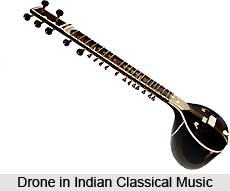 Drone in Indian Classical Music is one of the most vital melodic concepts. The drone on pitch Sa is an important component in both Hindustani and Carnatic Music. Drone is essentially the sounding of a constant melodic pitch or pitch sequence that underlines an elaborate melodic improvisation. It adds a harmonic element to the music. It is believed that the drone became a definite component of chamber ensembles only as late as the seventeenth century. In older music, the intervals between successive pitches were very important. Gradually, however, pitch Sa became more and more a point of reference, until the relationship between Sa and the other pitches in a Raaga became of prime importance. When the drone emerged in chamber music, the entire musicological system gradually changed and geared towards the description of musical elements in terms of Sa.
Drone in Indian Classical Music is one of the most vital melodic concepts. The drone on pitch Sa is an important component in both Hindustani and Carnatic Music. Drone is essentially the sounding of a constant melodic pitch or pitch sequence that underlines an elaborate melodic improvisation. It adds a harmonic element to the music. It is believed that the drone became a definite component of chamber ensembles only as late as the seventeenth century. In older music, the intervals between successive pitches were very important. Gradually, however, pitch Sa became more and more a point of reference, until the relationship between Sa and the other pitches in a Raaga became of prime importance. When the drone emerged in chamber music, the entire musicological system gradually changed and geared towards the description of musical elements in terms of Sa.
The sound of the drone serves two important functions: one, it frames the music, giving the musician a background of uniform sound upon which to sing or play, and creates an ambient quietness, like incense, which fills the atmosphere with mood. Second, it intones the tonal center, the Sa (usually along with the fifth or fourth), maintaining a pitch reference, and helping the musician stay in tune.
Instruments used in Drone Music
In both Hindustani and Carnatic music, the drone is played primarily on the Tambura. A tall instrument, from three and a half to five feet, the Tambura is a member of the lute family. The longest part of the Tambura is its hollow neck, which ends in a bowl, usually a large gourd (in the North) or a hollowed-out piece of jackfruit (in the South). This bowl is covered with a slightly convex piece of wood. The different sizes of Tamburas reflect the particular uses to which they are put. For convenience, small portable Tamburas are also made. These do not produce the volume and timbre of the full-sized ones, but they fulfill the same musical function. The Tambura usually has four strings, which extend from tuning pegs at the top end, down the long neck, over the wood sounding board and the bridge placed on it, to the underside of the gourd. The Tambura of South India is a somewhat more delicate instrument than its North Indian counterpart because its long neck is more slender.
The tuning of the Tambura is generally Pa Sa Sa Sa. It may also be tuned Ma Sa Sa Pa, Ni Sa Sa Pa, or even some other way, depending on the Raaga being performed. In performance, the Tambura is usually held vertically, with the bowl resting on the floor, or in the lap of the player. The index and middle fingers of the right hand are used to strum the strings: the middle finger plucks Pa, and the index finger slides across Sa Sa Sa.
Other instruments are used as drones, as well, such as small pumped reed boxes (surpeti), and nowadays one often hears an electronic version of a Tambura or Surpeti quietly droning in the background. These small "drone machines" are easier to transport than a Tambura, and they do not require an extra performer. Again, these drones- zithers, lutes, reeds, as well as harps- may have ancient roots as reinforcements of the focal pitch sa, the intoning of which can be heard as far back as in the chanting of the Vedas.




















